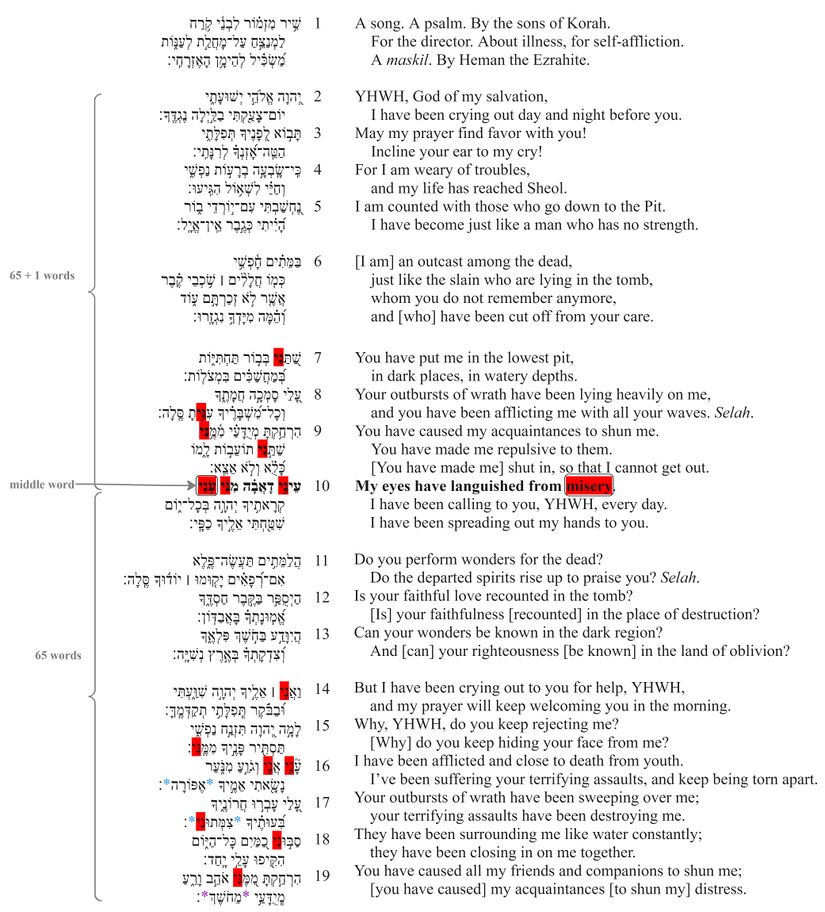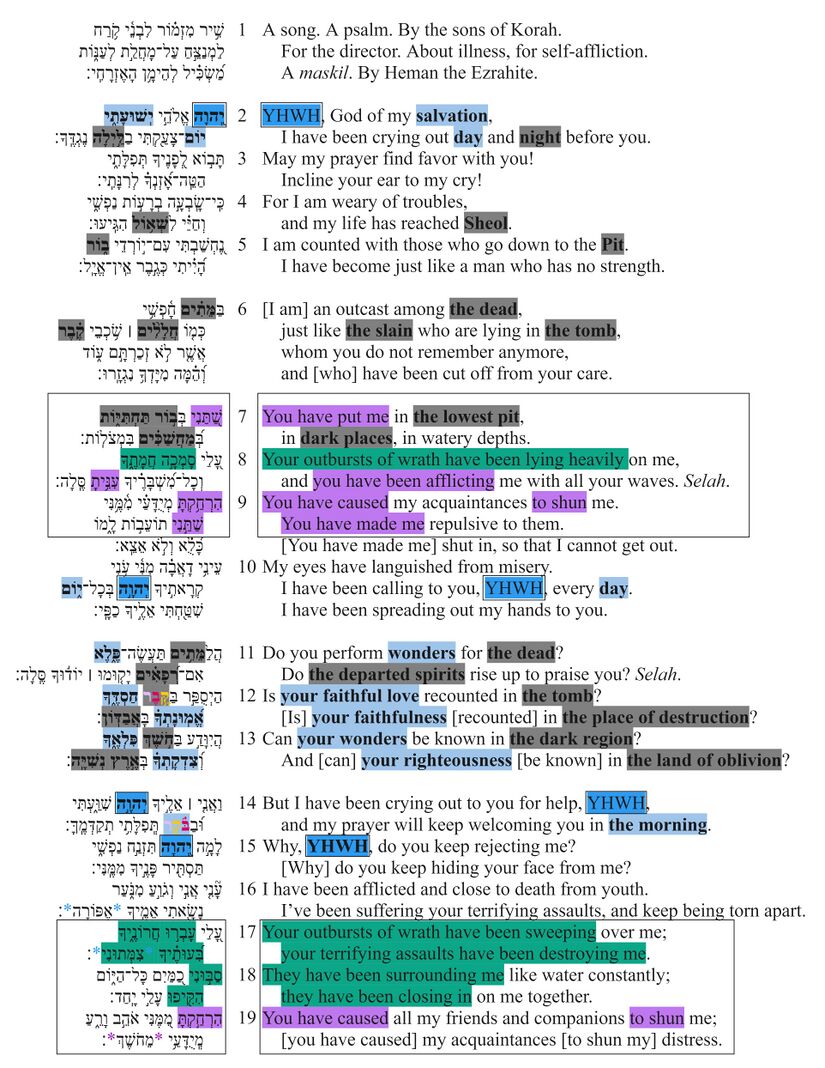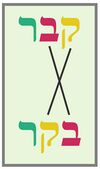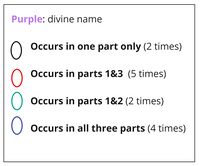Psalm 88 Poetic Features
Poetic Features
In poetic features, we identify and describe the “Top 3 Poetic Features” for each Psalm. Poetic features might include intricate patterns (e.g., chiasms), long range correspondences across the psalm, evocative uses of imagery, sound-plays, allusions to other parts of the Bible, and various other features or combinations of features. For each poetic feature, we describe both the formal aspects of the feature and the poetic effect of the feature. We assume that there is no one-to-one correspondence between a feature’s formal aspects and its effect, and that similar forms might have very different effects depending on their contexts. The effect of a poetic feature is best determined (subjectively) by a thoughtful examination of the feature against the background of the psalm’s overall message and purpose.
No Way Out
If an emendation or revocalization is preferred, that emendation or revocalization will be marked in the Hebrew text of all the visuals.
| Emendations/Revocalizations legend | |
|---|---|
| *Emended text* | Emended text, text in which the consonants differ from the consonants of the Masoretic text, is indicated by blue asterisks on either side of the emendation. |
| *Revocalized text* | Revocalized text, text in which only the vowels differ from the vowels of the Masoretic text, is indicated by purple asterisks on either side of the revocalization. |
- ** for revocalization see The Text and Meaning of Ps. 88:19b (MT: מַחְשָֽׁךְ).
- ** for emendation see The Text and Meaning of Ps. 88:16b (MT: אָפֽוּנָה).
- ** for emendation see the verse-by-verse note on v. 17b (MT: צִמְּתוּתֻֽנִי).
Feature
The vocalic sequence נִי is repeated 14 times in the psalm, in the second chiasm (vv. 7-19) bar the core from which the psalmist is absent (vv. 11-13). When it occurs, then it does once per line. In line 16a it is repeated twice as a sound play עָנִי אֲנִי, but it is only in line 10a that this sequence is repeated three times in a very condensed vocalic pattern. This line occupies a strategic position in the psalm, being line #20 in a psalm of 40 lines. In addition to that, we witness a concentric structure, with עֹנִי in v. 10a at the center, and the other instances of the vocalic sequence ני enveloping it more sparsely from both sides. A word count reveals that this word (עֹנִי) stands at the very center of the whole psalm (excluding the superscription), with exactly 65 words before and after (words joined by maqqef counted as separate words), and constitutes "the pivot of the psalm" (Van der Lugt 2014, 454).
Effect
The pun in line 16a creates an equation between the psalmist and misery: "The paronomasia suggests that “weakness” totally defines “me"" (Goldingay 2007); The repetitive sequence ני in vv. 7-10a keeps reminding one of the psalmist's miserable conditions, culminating in v. 10a where the psalmist finally cries out loud stating his misery explicitly. At the same time, the word עֹנִי, the pivot of the psalm, marks misery as a central motif and simultaneously places the psalmist (אני=עני) at its very core. The psalmist describes himself as trapped and surrounded by walls or enemies twice in the psalm, in v. 9c (quarantine) and v. 18 (surrounded by YHWH's terrifying assaults). The concentric structure mentioned above with the increasing tension leading up to an explosion of ני's in line 10a, culminating with the pivot (misery=the psalmist) iconically portrays that feeling of "no way out", of isolation which is a defining component of the psalmist's miserable condition. The psalmist is a prisoner not only in his own house, engulfed by "whirls of water," but also of his own misery.
The Primordial Elements
If an emendation or revocalization is preferred, that emendation or revocalization will be marked in the Hebrew text of all the visuals.
| Emendations/Revocalizations legend | |
|---|---|
| *Emended text* | Emended text, text in which the consonants differ from the consonants of the Masoretic text, is indicated by blue asterisks on either side of the emendation. |
| *Revocalized text* | Revocalized text, text in which only the vowels differ from the vowels of the Masoretic text, is indicated by purple asterisks on either side of the revocalization. |
- ** for revocalization see The Text and Meaning of Ps. 88:19b (MT: מַחְשָֽׁךְ).
- ** for emendation see The Text and Meaning of Ps. 88:16b (MT: אָפֽוּנָה).
- ** for emendation see the verse-by-verse note on v. 17b (MT: צִמְּתוּתֻֽנִי).
Feature
- בְּרֵאשִׁ֖ית בָּרָ֣א אֱלֹהִ֑ים אֵ֥ת הַשָּׁמַ֖יִם וְאֵ֥ת הָאָֽרֶץ׃ וְהָאָ֗רֶץ הָיְתָ֥ה תֹ֨הוּ֙ וָבֹ֔הוּ וְחֹ֖שֶׁךְ עַל־פְּנֵ֣י תְה֑וֹם וְר֣וּחַ אֱלֹהִ֔ים מְרַחֶ֖פֶת עַל־פְּנֵ֥י הַמָּֽיִם׃
- "In the beginning God created the heavens and the earth. The earth was formless and empty, and darkness covered the deep waters. And the Spirit of God was hovering over the surface of the waters." Gen 1:1-2 (NLT).
In the immortal first two verses of the Bible we read about the primordial elements that had existed before God started to put order in the universe and create life: earth, darkness and (deep) waters (=ׁתְּהוֹם, which in the Hebrew Bible stands for (a) the primordial ocean (b) underground water (BDB)). Upon examining the psalm we note that the only things the psalmist has direct physical contact with are the above three primordial elements: בוֹר תַּחְתִּיּוֹת, מַחֲשַׁכִּים, and מְצֹלוֹת (v. 7; it is noteworthy that in Exod 15:5 מְצֹלוֹת stands parallel to תְּהוֹם); מִשְׁבָּרֶיךָ (v. 8), מַיִם (v. 18) and מַחְשָׁךְ (v. 19). The psalmist, throughout almost the entire psalm, is passive, either subject to YHWH's afflictions or being avoided by the society and considered dead. It is therefore not the psalmist's choice to have these elements in his vicinity, them being forced on him by God. As someone who is (in the poetic metaphorical sense) in the Underworld, he is also surrounded by these elements there: בוֹר (v. 5a); אֶרֶץ, חֹשֶׁךְ(v. 13). The only places throughout the whole psalm where the psalmist is active and takes initiative are in the three invocations, in all of which a temporal word is mentioned: יוֹם and לַיְלָה (v. 2); יוֹם (v. 10b); בֹּקֶר (v. 14b). These four elements are already an integral part of the six days of creation, day and night being created on the first day, and morning being a derivative of the installation of the astronomical bodies on the fourth day.
Effect
The primordial elements represent the chaotic nature of the universe prior to creation. The poetics of the psalm portray them as the sole environment of the psalmist, symbolizing the chaos his life has become, having lost his social network, having lost control over his routine, passively being passed from the hands of one of YHWH's agents to the other.
The three latter elements, on the other hand, already part of creation and order, symbolize the psalmist's attempt to find some order and reason in his life. His only attempt to do something is in his routine prayers. The progression from day-night to the final morning in v. 14b injects some hope. However, all these elements, whether primordial or not, are lifeless. They are not part of the living creation. When we read the psalm from beginning to end we realize that the psalmist, whether passive or active, has direct contact and sole relation with (bar God) inanimate objects or concepts. Not a single mention of either vegetation or animals, even as imagery, is made. His friends are gone. He is not surrounded by life, but by death only. In fact, the very last word of the psalm, חֹשֶׁךְ, becomes synonymous with him, symbolizing his distress: the psalmist has been "infected" by death, which has become part of his own self.
From Despair to Submission
If an emendation or revocalization is preferred, that emendation or revocalization will be marked in the Hebrew text of all the visuals.
| Emendations/Revocalizations legend | |
|---|---|
| *Emended text* | Emended text, text in which the consonants differ from the consonants of the Masoretic text, is indicated by blue asterisks on either side of the emendation. |
| *Revocalized text* | Revocalized text, text in which only the vowels differ from the vowels of the Masoretic text, is indicated by purple asterisks on either side of the revocalization. |
- ** for revocalization see The Text and Meaning of Ps. 88:19b (MT: מַחְשָֽׁךְ).
- ** for emendation see The Text and Meaning of Ps. 88:16b (MT: אָפֽוּנָה).
- ** for emendation see the verse-by-verse note on v. 17b (MT: צִמְּתוּתֻֽנִי).
Feature
Three independent poetic features are interwoven in the psalm, each contributing to the main hidden message of the psalm. Since the effect of these poetic features builds up synergically with one another, they were grouped together under one poetic feature.
- Vocatives: The psalm has three direct invocations to YHWH in which the psalmist proclaims his daily prayers and insists that he has fulfilled his part of the covenant. These invocations are located in vv. 2, 10bc and 14-15. We can notice that the vocative YHWH moves one slot forward from one invocation to the next one. However, the last vocative in the series, in v. 15, moves one slot backwards.
- Contrasting words: The psalm starts, in v. 2, with a call to YHWH the God of salvation (יְשׁוּעָתִי), followed by יוֹם, which is negated in the same verse by לַּ֣יְלָה. The latter opens a long series of terms that refer to death, either to the Underworld or to the dead (see words highlighted in grey in the visual, starting at v. 4). It is only in v. 10 that יוֹם is back to mark the beginning of a section (vv. 11-13) containing an interesting mixture of words of both types: those denoting death and those denoting God's, the source of life, loving attributes (see words highlighted in light blue in the visual). Starting from v. 14 all the death words disappear for good[1] and the whole line of contrasting terms is concluded by בֹּקֶר in v. 14, a prominent metathesis of קֶבֶר in v. 12 (see image to the right).
- God's vs. God's agents' affliction: We find yet another contrasting pattern in the psalm: in vv. 7-9b and 17-19, the ones that contain the direct accusations of YHWH, we come across a series of painful acts inflicted upon the psalmist on YHWH's initiative. Each of these acts has either YHWH or one of his agents (see participant analysis) as the direct agent and formal subject of the respective verb. In vv. 7-9b YHWH is the second person subject of four verbs while his agents are the third person subject of one verb only, whereas in vv. 17-19 we find an opposite one-to-four count respectively.
Effect
Upon a first superficial reading, the reader might find the psalm only gloomy, with no ray of light or hope, and an ongoing bitter tone. In spite of the initial proclamation of YHWH as "God of my salvation", the word "night" in the same verse quickly shifts the reader's attention to the psalmist's misery and bleak perspective enhanced by all those words denoting death. The psalmist's misery indeed continues up until the very end of the psalm, and we even see how YHWH is going further away from the psalmist along the line of vocatives, BUT the last of these vocatives, in v. 15, actually brings YHWH back closer to him. The turning point is in fact in vv. 11-13, the rhetorical climax of the psalm. It is here that the negative words are numerically balanced with the positive ones. The psalmist's attempt to convince God to save him brings back to mind that whatever God does, it is always motivated by his faithfulness and loving character. This realization brings the psalm to its emotional climax in v. 14b, poetically symbolized by "the morning": the psalmist may not know the reason why YHWH is afflicting him, but that is not important anymore. Whether he has managed to convince God or not, whether he is going to die as a scapegoat or not - death is no longer his concern, because God does everything out of his faithful love. The psalmist has now accepted this fact and therefore starts to see the light of the morning. He also realizes or experiences that God has not completely abandoned him as he originally thought, which is symbolized by the last vocative drawing nearer in v. 15. The psalmist is going to keep praying to God as long as he can, keeping his covenant with him (cf. Story Behind). Having realized that, the psalmist also mitigates his accusation of God: in vv. 7-9b he bluntly accuses God using mostly direct second person verbal forms, while in the last section of the psalm in vv. 17-19 it is mostly YHWH's agents that are the third person subjects of the series of accusations.
Repeated Roots
The repeated roots table is intended to identify the roots which are repeated in the psalm.
Notes
Given the tripartite division of the psalm, the structural patterns of the repeated roots above have been created in light of such a division, instead of one based on one line of symmetry. Four of these repeated roots are repeated in all three parts, and five of them are repeated only in parts 1 & 3, while only two connect between parts 1 & 2. This shows a strong affinity between parts 1 & 3 and a much less strong one between part 2 and the two other parts. It is also interesting to note that while the root ידע appears in all three parts, it is repeated by the same lexical item only in parts 1 & 3 (מְיֻדָּע), while in part 2 it is represented by a completely different lexeme (the verb יִוָּדַע).
- ↑ We read the concluding word of the psalm חֹשֶׁךְ, not as representing the underworld, but as a metaphor to the psalmist's miserable conditions (cf. The Text and Meaning of Ps. 88:19b).







